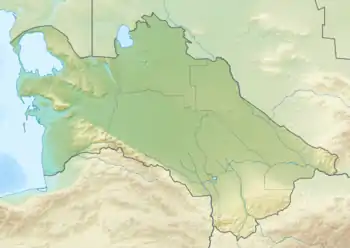Ulug Depe
Ulug Depe is an ancient Bronze Age site in the foothills of the Kopet Dag Mountains in the Karakum Desert of Kaka District (Kaahka) in the Ahal Province of south-eastern Turkmenistan. It covers around 13 hectares and lies on a mound at a height of about 30 meters, displaying the longest stratigraphic sequence of Central Asia, from the Late Neolithic, represented by Jeitun culture, until the pre-Achaemenid period.[1][2][3]
Ulug depe (in Turkmen) | |
 Location in Turkmenistan | |
| Coordinates | 37°9′20.23″N 60°1′46.02″E |
|---|---|
| History | |
| Periods | Bronze Age |
| Cultures | BMAC |
History
The following table, by Olivier Lecomte, brings the chronology for South Central Asia and Ulug-depe settlement:[4]
| Period | Dates |
|---|---|
| Neolithic of Jeitun type | 6200–5000 BCE |
| Proto-Chalcolithic (Anau Ia) | 5200–4800 BCE |
| Early-Chalcolithic (Namazga I) | 4800–4000 BCE |
| Middle-Chalcolithic (Namazga II) | 4000–3500 BCE |
| Late-Chalcolithic (Namazga III) | 3500–3000 BCE |
| Early Bronze (Namazga IV) | 3000–2500 BCE |
| Middle Bronze (Namazga V) | 2500–2200 BCE |
| Late Bronze (Namazga VI) | 2200–1500 BCE |
| Late Bronze (Margiana, Gonur phase) | 2200–1800 BCE |
| Late Bronze (Margiana, Togolok phase) | 1800–1500 BCE |
| Early Iron (Yaz I) | 1500–1100 BCE |
| Archaic Dehistan (SW Turkmenistan) | 1300–500 BCE |
| Pre-Achaemenid and Achaemenid (Yaz II-III) | 1100–329 BCE |
Discoveries
Excavations in the Late Bronze layers also found a "pressure set" for making soma drink. This set, similar to those found in Gonur Depe,
- "... consisted of a huge stone mortar and a pestle, a pressing stone with a half-spheric projection in its centre, and next to it a similar one with a half-spheric deepening."[5]
Gonur Depe seems to be the central city on the ancient Oxus civilization, also known as the Bactria–Margiana Archaeological Complex, from about 2000 BCE.[6]
See also
References
- Lhuillier, J., (2016)."Ulug-depe and the transition period from Bronze Age to Iron Age in Central Asia: A Tribute to V. I. Sarianidi" Archived 2020-12-23 at the Wayback Machine in Transactions of Margiana Archaeological Expedition Vol. 6, p. 509. (Academia.edu Archived 2020-12-23 at the Wayback Machine)
- Brummell, Paul (2006). Bradt Travel Guide Turkmenistan. Bradt Travel Guides. p. 127. ISBN 1-84162-144-7.
- "French archaeologists present new findings to Ak Bugdai museum". turkmenistan.ru. October 31, 2007. Retrieved November 1, 2009.
- Lecomte, Olivier, (2011)."Ulug-depe: 4000 Years of Evolution between Plain and Desert" Archived 2020-06-23 at the Wayback Machine, in Historical and Cultural Sites of Turkmenistan, p. 223.
- Victor Sarianidi, Margiana and Soma-Haoma. Electronic Journal of Vedic Studies (EJVS), Vol. 9 (2003) Issue 1c (May 5); archived 10 May 2020
- "La mission archéologique Franco-Turkmène" (in French). Guimet National Museum of Asian Arts. Archived from the original on March 11, 2008. Retrieved November 1, 2009.
External links
- Turkménistan - Ulug Depe (in French) (Includes photos and a reconstruction of the ancient city)
- La mission archéologique Franco-Turkmène (in French)
- Monnereau A., Lhuillier J., Bendezu-Sarmiento J., Bon C. Palaeogenetic analysis of Bronze Age/Iron Age transition in Southern Central Asia, poster, 6th DNA Polymorphisms in Human Populations, Musee de l’Homme, Paris, 7-10 December, 2016 (ResearchGate, June 2017)
- Johanna Lhuillier; Armance Dupont-Delaleuf; Olivier Lecomte; Julio Bendezu-Sarmiento (2013), "The Middle Iron Age in Ulug depe: a preliminary typo-chronological and technological study of the Yaz II ceramic complex", in Marcin Wagner (ed.), Pottery chronology of the Early Iron Age in Central Asia, Kazimierz Michałowski Foundation, Institute of Archaeology, University of Warsaw, pp. 9–28